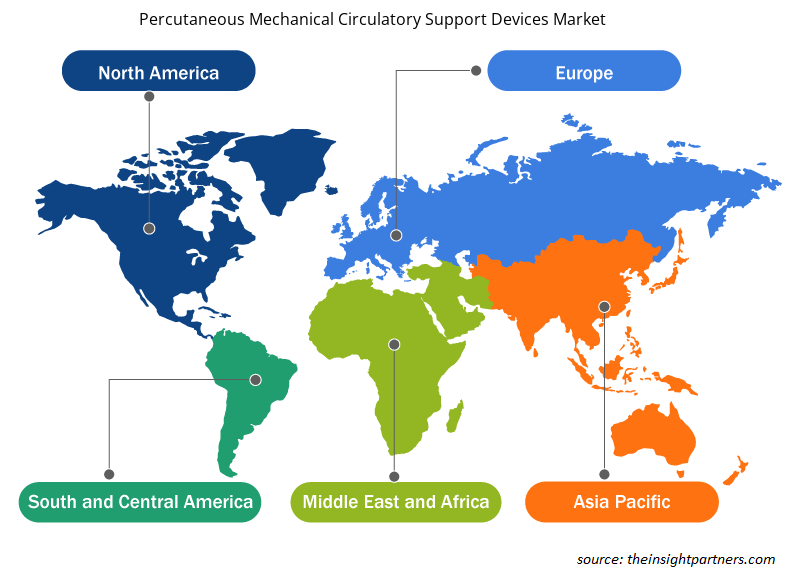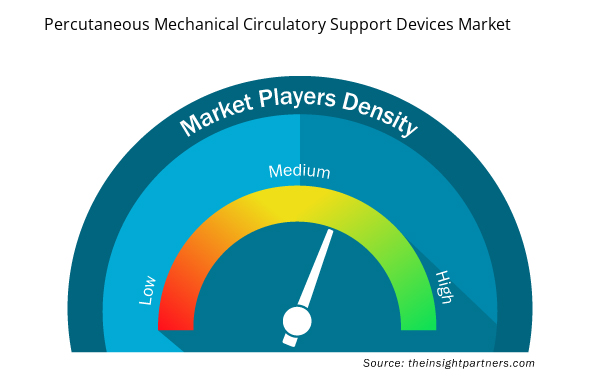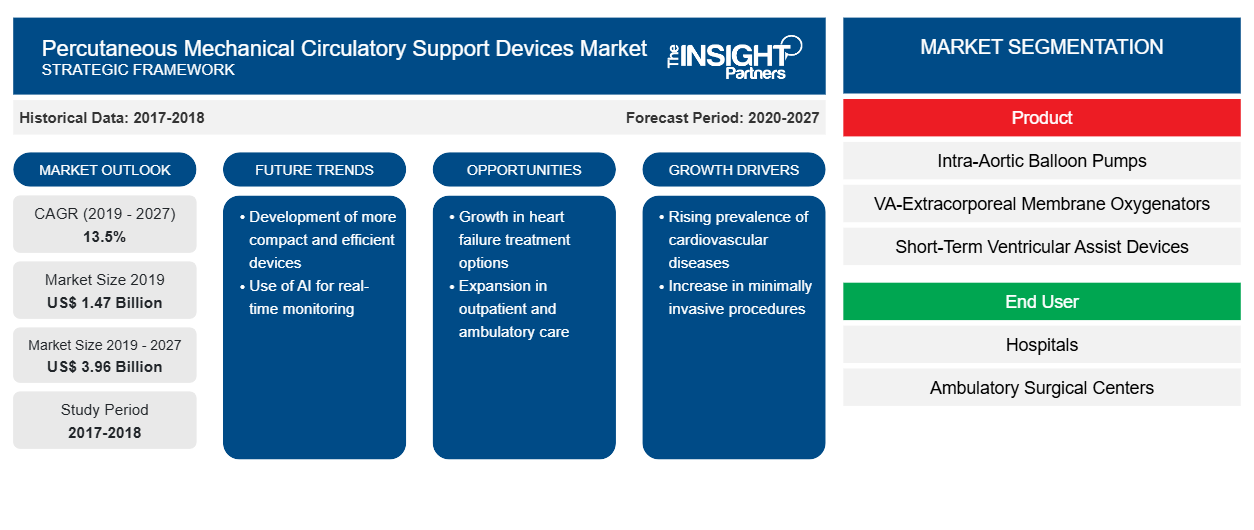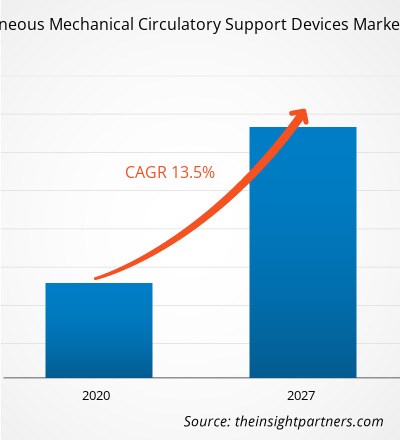El mercado de dispositivos de soporte circulatorio mecánico percutáneo se valoró en US$ 1.474,28 millones en 2019 y se proyecta que alcance los US$ 3.964,75 millones para 2027; se espera que crezca a una CAGR del 13,5% durante 2020-2027.
Los dispositivos de asistencia circulatoria mecánica percutánea ofrecen un enfoque eficaz y rápido para frenar la espiral descendente de inestabilidad hemodinámica entre los pacientes que sufren insuficiencias cardíacas descompensadas y choques cardiogénicos hasta que se perciba una estrategia más definitiva entre los pacientes para recuperarse de estas dolencias cardíacas. Las principales funciones de los dispositivos de asistencia circulatoria mecánica percutánea incluyen mejorar el gasto cardíaco nativo, reducir el volumen ventricular y las presiones de llenado, aumentar la perfusión coronaria y mantener la perfusión de los órganos vitales.
Perspectivas de mercado
Aumento de la población geriátrica
Se prevé un alto crecimiento del mercado debido al aumento de la población geriátrica mundial. Tanto en la población masculina como en la femenina, el riesgo de enfermedades cardiovasculares aumenta con el aumento de la edad. Los vasos sanguíneos envejecidos son menos flexibles, lo que conduce a una reducción del flujo sanguíneo. Por lo tanto, el riesgo de enfermedad cardíaca es alto en la población de edad avanzada. Además, según las Estadísticas de enfermedades cardíacas y accidentes cerebrovasculares de 2018, la edad promedio en el primer ataque cardíaco es de 65,6 años para los hombres y de 72,0 años para las mujeres. También se mencionó que la incidencia anual de un ataque cardíaco en los EE. UU. es de 720 000 ataques nuevos y 335 000 ataques recurrentes. Además, según los Institutos Nacionales de Salud (NIH), se proyecta que la población estadounidense de 65 años o más casi se duplicará en las próximas tres décadas, de 48 millones a 88 millones para 2050. La enfermedad cardiovascular (ECV) en los estadounidenses mayores impone una enorme carga en términos de mortalidad, morbilidad, discapacidad, deterioro funcional y costos de atención médica. Un estudio retrospectivo realizado por la Universidad de Pittsburgh en 2015 afirma que la prevalencia de ECV, incluida la hipertensión, la cardiopatía coronaria, la insuficiencia cardíaca y el accidente cerebrovascular, aumenta de aproximadamente el 40 % en hombres y mujeres de 40 a 59 años y del 70 al 75 % en personas de 60 a 79 años, y del 79 al 86 % entre las personas de 80 años o más. Por lo tanto, la creciente población geriátrica que conduce a mayores riesgos de insuficiencia cardíaca y choques cardiogénicos aumenta las aplicaciones de dispositivos de asistencia circulatoria mecánica percutánea y, en última instancia, favorece el crecimiento del mercado.
Personalice este informe según sus necesidades
Obtendrá personalización en cualquier informe, sin cargo, incluidas partes de este informe o análisis a nivel de país, paquete de datos de Excel, así como también grandes ofertas y descuentos para empresas emergentes y universidades.
- Obtenga las principales tendencias clave del mercado de este informe.Esta muestra GRATUITA incluirá análisis de datos, desde tendencias del mercado hasta estimaciones y pronósticos.
Perspectivas de mercado basadas en productos
El segmento de productos del mercado de dispositivos de asistencia circulatoria mecánica percutánea se divide en bombas de balón intraaórticas, oxigenación por membrana extracorpórea VA y dispositivos de asistencia ventricular de corta duración. El segmento de bombas de balón intraaórticas tuvo la mayor participación en el mercado de dispositivos de asistencia circulatoria mecánica percutánea en 2019. Se prevé que el segmento de dispositivos de asistencia ventricular de corta duración crezca a una CAGR del 14,0 % durante el período de pronóstico.
Información de mercado basada en el usuario final
El segmento de usuarios finales del mercado de dispositivos de asistencia circulatoria mecánica percutánea está segmentado por hospitales, centros quirúrgicos ambulatorios y otros. El segmento de hospitales tuvo la mayor participación del mercado de dispositivos de asistencia circulatoria mecánica percutánea en 2019. También se prevé que el segmento crezca a una CAGR del 14,2 % durante el período de pronóstico.
Las estrategias de lanzamiento y aprobación de productos son comúnmente adoptadas por las empresas para expandir su presencia y su cartera de productos en todo el mundo y satisfacer la creciente demanda.
Además, los actores del mercado que operan en el mercado de dispositivos de asistencia circulatoria mecánica percutánea adoptan la estrategia de expansión para ampliar la base de clientes en todo el mundo, lo que les permite mantener su marca a nivel mundial. Por ejemplo, en junio de 2016, Medetronic lanzó un producto: Beacon, un servicio de gestión de atención para pacientes con insuficiencia cardíaca de alto riesgo. Este servicio combina datos de desfibriladores cardioversores implantables (ICD) o dispositivos de terapia de resincronización cardíaca (CRT) de Medtronic con monitoreo postagudo de MCMS.
Perspectivas regionales del mercado de dispositivos de asistencia circulatoria mecánica percutánea
Los analistas de Insight Partners explicaron en detalle las tendencias y los factores regionales que influyen en el mercado de dispositivos de asistencia circulatoria mecánica percutánea durante el período de pronóstico. Esta sección también analiza los segmentos y la geografía del mercado de dispositivos de asistencia circulatoria mecánica percutánea en América del Norte, Europa, Asia Pacífico, Oriente Medio y África, y América del Sur y Central.

- Obtenga datos regionales específicos para el mercado de dispositivos de soporte circulatorio mecánico percutáneo
Alcance del informe de mercado sobre dispositivos de asistencia circulatoria mecánica percutánea
| Atributo del informe | Detalles |
|---|---|
| Tamaño del mercado en 2019 | 1.470 millones de dólares estadounidenses |
| Tamaño del mercado en 2027 | 3.960 millones de dólares estadounidenses |
| CAGR global (2019-2027) | 13,5% |
| Datos históricos | 2017-2018 |
| Período de pronóstico | 2020-2027 |
| Segmentos cubiertos | Por producto
|
| Regiones y países cubiertos | América del norte
|
| Líderes del mercado y perfiles de empresas clave |
|
Densidad de actores del mercado: comprensión de su impacto en la dinámica empresarial
El mercado de dispositivos de asistencia circulatoria mecánica percutánea está creciendo rápidamente, impulsado por la creciente demanda de los usuarios finales debido a factores como la evolución de las preferencias de los consumidores, los avances tecnológicos y una mayor conciencia de los beneficios del producto. A medida que aumenta la demanda, las empresas amplían sus ofertas, innovan para satisfacer las necesidades de los consumidores y aprovechan las tendencias emergentes, lo que impulsa aún más el crecimiento del mercado.
La densidad de actores del mercado se refiere a la distribución de las empresas o firmas que operan dentro de un mercado o industria en particular. Indica cuántos competidores (actores del mercado) están presentes en un espacio de mercado determinado en relación con su tamaño o valor total de mercado.
Las principales empresas que operan en el mercado de dispositivos de soporte circulatorio mecánico percutáneo son:
- Abad.
- Medtronic
- Getinge AB
- Teleflex Incorporated
- Livanova Plc (Cardiacassist, Inc.).
Descargo de responsabilidad : Las empresas enumeradas anteriormente no están clasificadas en ningún orden particular.

- Obtenga una descripción general de los principales actores clave del mercado de dispositivos de soporte circulatorio mecánico percutáneo
Mercado mundial de dispositivos de asistencia circulatoria mecánica percutánea: por producto
- Bombas de balón intraaórticas
- VA-Oxigenación por membrana extracorpórea (ECMO)
- Oxigenadores
- Dispositivos de asistencia ventricular de corta duración (VAD)
- Impela
- Corazón en tándem
Mercado mundial de dispositivos de asistencia circulatoria mecánica percutánea (por usuario final)
- Hospitales
- Centros de cirugía ambulatoria
- Otros
Dispositivos de asistencia circulatoria mecánica percutánea a nivel mundial, por geografía
América del norte
- A NOSOTROS
- Canadá
- México
Europa
- Francia
- Alemania
- Italia
- Reino Unido
- España
- Resto de Europa
Asia Pacífico (APAC)
- Porcelana
- India
- Corea del Sur
- Japón
- Australia
- Resto de APAC
Oriente Medio y África (MEA)
- Sudáfrica
- Arabia Saudita
- Emiratos Árabes Unidos
- Resto de MEA
América del Sur (SAM)
- Brasil
- Argentina
- Resto de SAM
Perfiles de empresas
- Abad.
- Medtronic
- Getinge AB
- Teleflex Incorporated
- LivanovaPlc (Cardiacassist, Inc.).
- Abiomed
- Conjuntos de euros
- Corazón de Berlín
- Corazón de Jarvik, Inc.
- CardioBridge GmbH
- Análisis histórico (2 años), año base, pronóstico (7 años) con CAGR
- Análisis PEST y FODA
- Tamaño del mercado Valor/volumen: global, regional, nacional
- Industria y panorama competitivo
- Conjunto de datos de Excel



Report Coverage
Revenue forecast, Company Analysis, Industry landscape, Growth factors, and Trends

Segment Covered
This text is related
to segments covered.

Regional Scope
North America, Europe, Asia Pacific, Middle East & Africa, South & Central America

Country Scope
This text is related
to country scope.
Preguntas frecuentes
The North American region holds the largest market for the breast cancer screening. The United States held the largest market for percutaneous mechanical circulatory support devices market and is expected to grow due to factors such as increasing number ofincreasing prevalence of cardiovascular diseases & heart failures, growing developments for screening and imaging process by the companies and others.
The growth of the market is attributed to some key driving factors such as rising geriatric population, increasing prevalence of cardiovascular diseases & heart failures however, impact of COVID-19 pandemic on medical device industry and high cost of products and procedures is expected to restraint the growth of the market during the forecast years.
The percutaneous mechanical circulatory support devices market is highly competitive in nature with considerable number of players, having a high level of consolidation overall revenue share. Most of the companies operating in the percutaneous mechanical circulatory support devices market are present globally and have wide distribution and sales network through partnerships or authorized dealers.
Trends and growth analysis reports related to Life Sciences : READ MORE..
The List of Companies - Percutaneous Mechanical Circulatory Support Devices Market
- Abbott.
- Medtronic
- Getinge AB
- Teleflex Incorporated
- Livanova Plc (Cardiacassist, Inc.).
- Abiomed
- Eurosets
- Berlin Heart
- Jarvik Heart, Inc.
- CardioBridge GmbH
The Insight Partners performs research in 4 major stages: Data Collection & Secondary Research, Primary Research, Data Analysis and Data Triangulation & Final Review.
- Data Collection and Secondary Research:
As a market research and consulting firm operating from a decade, we have published and advised several client across the globe. First step for any study will start with an assessment of currently available data and insights from existing reports. Further, historical and current market information is collected from Investor Presentations, Annual Reports, SEC Filings, etc., and other information related to company’s performance and market positioning are gathered from Paid Databases (Factiva, Hoovers, and Reuters) and various other publications available in public domain.
Several associations trade associates, technical forums, institutes, societies and organization are accessed to gain technical as well as market related insights through their publications such as research papers, blogs and press releases related to the studies are referred to get cues about the market. Further, white papers, journals, magazines, and other news articles published in last 3 years are scrutinized and analyzed to understand the current market trends.
- Primary Research:
The primarily interview analysis comprise of data obtained from industry participants interview and answers to survey questions gathered by in-house primary team.
For primary research, interviews are conducted with industry experts/CEOs/Marketing Managers/VPs/Subject Matter Experts from both demand and supply side to get a 360-degree view of the market. The primary team conducts several interviews based on the complexity of the markets to understand the various market trends and dynamics which makes research more credible and precise.
A typical research interview fulfils the following functions:
- Provides first-hand information on the market size, market trends, growth trends, competitive landscape, and outlook
- Validates and strengthens in-house secondary research findings
- Develops the analysis team’s expertise and market understanding
Primary research involves email interactions and telephone interviews for each market, category, segment, and sub-segment across geographies. The participants who typically take part in such a process include, but are not limited to:
- Industry participants: VPs, business development managers, market intelligence managers and national sales managers
- Outside experts: Valuation experts, research analysts and key opinion leaders specializing in the electronics and semiconductor industry.
Below is the breakup of our primary respondents by company, designation, and region:

Once we receive the confirmation from primary research sources or primary respondents, we finalize the base year market estimation and forecast the data as per the macroeconomic and microeconomic factors assessed during data collection.
- Data Analysis:
Once data is validated through both secondary as well as primary respondents, we finalize the market estimations by hypothesis formulation and factor analysis at regional and country level.
- Macro-Economic Factor Analysis:
We analyse macroeconomic indicators such the gross domestic product (GDP), increase in the demand for goods and services across industries, technological advancement, regional economic growth, governmental policies, the influence of COVID-19, PEST analysis, and other aspects. This analysis aids in setting benchmarks for various nations/regions and approximating market splits. Additionally, the general trend of the aforementioned components aid in determining the market's development possibilities.
- Country Level Data:
Various factors that are especially aligned to the country are taken into account to determine the market size for a certain area and country, including the presence of vendors, such as headquarters and offices, the country's GDP, demand patterns, and industry growth. To comprehend the market dynamics for the nation, a number of growth variables, inhibitors, application areas, and current market trends are researched. The aforementioned elements aid in determining the country's overall market's growth potential.
- Company Profile:
The “Table of Contents” is formulated by listing and analyzing more than 25 - 30 companies operating in the market ecosystem across geographies. However, we profile only 10 companies as a standard practice in our syndicate reports. These 10 companies comprise leading, emerging, and regional players. Nonetheless, our analysis is not restricted to the 10 listed companies, we also analyze other companies present in the market to develop a holistic view and understand the prevailing trends. The “Company Profiles” section in the report covers key facts, business description, products & services, financial information, SWOT analysis, and key developments. The financial information presented is extracted from the annual reports and official documents of the publicly listed companies. Upon collecting the information for the sections of respective companies, we verify them via various primary sources and then compile the data in respective company profiles. The company level information helps us in deriving the base number as well as in forecasting the market size.
- Developing Base Number:
Aggregation of sales statistics (2020-2022) and macro-economic factor, and other secondary and primary research insights are utilized to arrive at base number and related market shares for 2022. The data gaps are identified in this step and relevant market data is analyzed, collected from paid primary interviews or databases. On finalizing the base year market size, forecasts are developed on the basis of macro-economic, industry and market growth factors and company level analysis.
- Data Triangulation and Final Review:
The market findings and base year market size calculations are validated from supply as well as demand side. Demand side validations are based on macro-economic factor analysis and benchmarks for respective regions and countries. In case of supply side validations, revenues of major companies are estimated (in case not available) based on industry benchmark, approximate number of employees, product portfolio, and primary interviews revenues are gathered. Further revenue from target product/service segment is assessed to avoid overshooting of market statistics. In case of heavy deviations between supply and demand side values, all thes steps are repeated to achieve synchronization.
We follow an iterative model, wherein we share our research findings with Subject Matter Experts (SME’s) and Key Opinion Leaders (KOLs) until consensus view of the market is not formulated – this model negates any drastic deviation in the opinions of experts. Only validated and universally acceptable research findings are quoted in our reports.
We have important check points that we use to validate our research findings – which we call – data triangulation, where we validate the information, we generate from secondary sources with primary interviews and then we re-validate with our internal data bases and Subject matter experts. This comprehensive model enables us to deliver high quality, reliable data in shortest possible time.


 Obtenga una muestra gratuita de este informe
Obtenga una muestra gratuita de este informe